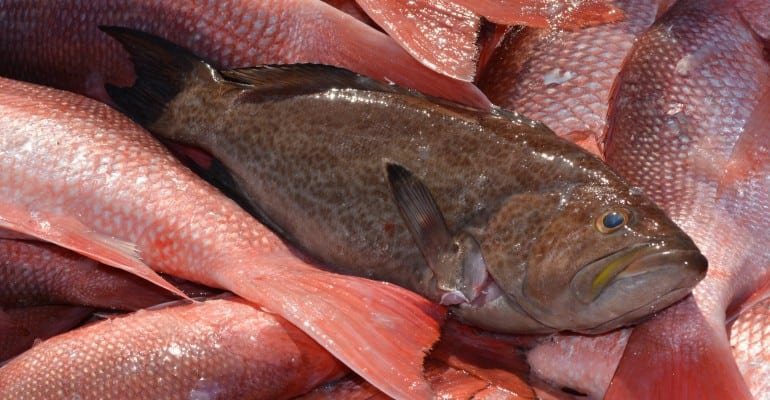The Gulf of Mexico Fishery Management Council met this week in Biloxi, Mississippi and took final action on Reef Fish Amendment 50: State Management for Recreational Red Snapper.
The Council chose to delegate management authority of the private angling component for recreational red snapper fishing to each state. Each state will be allocated the portion of the recreational quota it initially requested in the 2018-2019 exempted fishing permit application, with the remaining 3.78% distributed between Florida and Alabama. Those values are as follows:
|
Alabama
|
Florida
|
Louisiana
|
Mississippi
|
Texas
|
|
26.298%
|
44.822%
|
19.120%
|
3.550%
|
6.210%
|
The Council also elected to delegate authority for establishing or modifying the bag limit, minimum size limit within 14-18 inches, and maximum size limit. Finally, the Council selected to allow a state to close areas of federal waters adjacent to the state by requesting that NMFS implement the closure.
These suggested management changes will be transmitted to the Secretary of Commerce for approval and implementation.
What happens now?
State management will begin with the 2020 private recreational red snapper season. Anglers should see fishing seasons similar to what they experienced in 2018 and 2019.
The Louisiana Wildlife and Fisheries Commission will establish rules for the state’s red snapper fishery. The department will manage the resource effectively and have the ability to close the season quickly, when needed, to prevent overfishing.
The Commission now has the authority to set seasons, bag and size limits, and other management regulations for private recreational red snapper fishing in federal waters (out to 200 nautical miles).
“This decision is the result of Gov. John Bel Edwards’ directive to me and the LDWF staff to get this done for our anglers,” said LDWF Secretary Jack Montoucet. “Now we will show that Louisiana can manage efffectively and that we have all of the intangibles to make this work.”
Gov. Edwards, an avid fisherman, said, that the vote is extra special for him.
“This is a victory for our anglers,” Gov. Edwards said today. “Very shortly, they will be able to spend more time fishing for red snapper on the water in our beautiful Sportsman’s Paradise. One of my goals is to have our state manage red snapper in both state and federal waters. I’m very thankful to our Wildlife and Fisheries leadership, our anglers, congressional delegation and fishing organizations who helped to make this happen.”
LDWF also fought successfully at the Gulf Council meeting for Louisiana’s historical 19.1 percent of the private recreational red snapper quota, which will result in an allocation of 816,439 pounds in 2019. By comparison, Louisiana private anglers caught approximately 738,000 pounds during the 2018 season.
The state management amendment, passed today, will require any Gulf state that exceeds its quota in a season to “pay it back” the following year or allow the carry over of uncaught quota the following season.
Patrick Banks, the assistant secretary of fisheries, who has lead the negotiations at the Gulf Council, said the old system of federal management often left Louisiana anglers at a disadvantage. Weather was usually better in the eastern Gulf which allowed anglers in Florida, Alabama and Mississippi to have a greater chance of catching their quota than Louisiana anglers.
“Now we have a certain amount of fish reserved just for us. Our Wildlife and Fisheries Commission sets the season for our anglers to catch that set amount of fish and they can set that season whenever they want that best fits our anglers and ensures responsible harvest levels,” Banks said.
Reaching this pivotal point in fisheries management has been years in the making. Efforts began at the June 2016 GMFMC meeting in Florida, where LDWF guided the successful passage of a motion to begin work on a plan to establish state management of red snapper for the private recreational fishing sector.
(The GMFMC is a 17-member group representing Louisiana, Texas Florida, Alabama, and Mississippi. It is responsible for developing and monitoring fishery management plans to provide for the best use of the fishery resources in the Gulf of Mexico.)
The department has worked with National Oceanic and Atmospheric Administration Fisheries and the Gulf Council to provide Louisiana’s private recreational anglers with 42 days of red snapper fishing in federal waters in 2017 and 60 days in 2018, an increase from the 11 days available in 2016, when LDWF first began working on this plan.
Louisiana is currently operating under its second year of an Exempted Fishing Permit, which authorizes activities that would otherwise be prohibited by federal fishery regulations, for limited testing, data collection, exploratory fishing and other purposes. Under this two-year pilot EFP study, the private recreational red snapper fishing season structure was delegated to LDWF.
The EFP allowed LDWF to collect data from anglers on how they want to distribute their effort and whether electronic reporting can help decrease uncertainty around our harvest estimate. Under the EFP, the department was able to gather these data without impacting other states and without sacrifices from our participants.
The foundation of state management was established through LA Creel, which closely monitors recreational landings of red snapper. Voluntary electronic reporting, through the LDWF mobile phone app, is being tested to further bolster the catch and effort data collected by LA Creel. NOAA Fisheries announced the certification of LA Creel survey design in December 2017. LA Creel is a critical component to managing red snapper harvest because it makes landings data available more quickly than was possible with NOAA’s Marine Recreational Information Program (MRIP) and is more flexible and responsive to management needs.
A significant benefit of the EFP working in combination with LA Creel was that Louisiana private anglers had their own quota that included both state and federal waters. Previously, NOAA estimated how long it would it would take for anglers throughout the gulf to harvest the quota based on prior years’ information. Those estimates were unable to take current conditions into account, leading to over-runs.
This high effort would force NOAA to establish short federal seasons. Louisiana anglers had less opportunity to fish, and anglers across the Gulf were feeling forced to go out more often than normal because of the short seasons. Parsing out Louisiana’s quota through historical averages removed us from the ‘race for fish’ and allows us to catch our own quota at our own pace.
Louisiana will continue to manage the red snapper season in a responsible fashion by utilizing LA Creel data to closely monitor harvest to close the season once our quota is met. LDWF continues to encourage anglers to participate in voluntary electronic reporting of their red snapper fishing activities.





